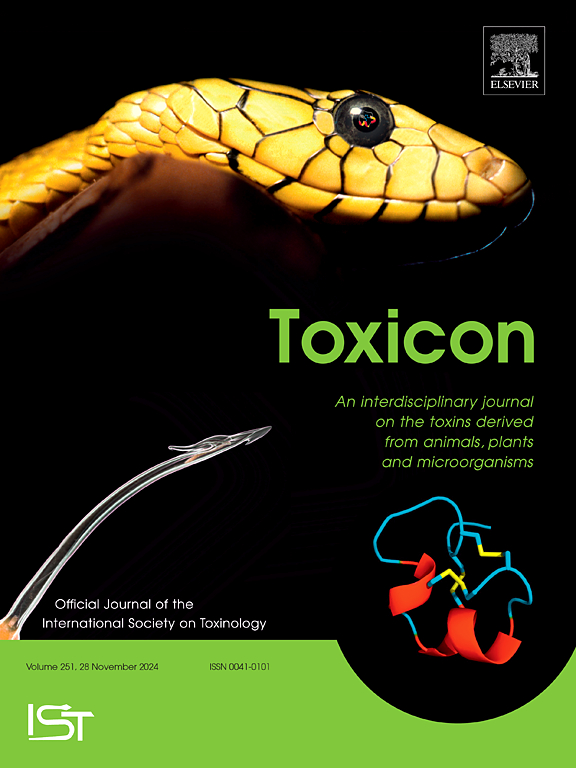Evaluation of some blood chemistry parameters caused by different venom doses of Tityus and Centruroides scorpion species from Panama
IF 2.6
4区 医学
Q2 PHARMACOLOGY & PHARMACY
引用次数: 0
Abstract
Medically important scorpions in Panama belong to the Tityus and Centruroides genus, including species such as Tityus (Atreus) sp., T. championi, T. festae, C. bicolor, and C. limbatus, which can cause blood chemistry alterations. Therefore, obtaining data through experimental models is crucial for understanding scorpion envenomation. Five scorpion venoms were individually inoculated intravenously into mice (CD-1 strain; 18–20 g) at doses ranging from 0.5 to 1.5 LD50 for each scorpion venom. The control group received only a 0.9 % sodium chloride solution. Blood samples were obtained by intracardiac puncture and were analyzed at times from 5, 15, 30 min, 1, 3, and 24 h. Serum glucose, amylase, CK, CK-MB, creatinine, urea nitrogen, sodium, and potassium levels were determined. It was found that Panamanian scorpion venoms can cause pancreatic damage, as indicated by an increase in glucose and amylase levels, as well as cardiac and muscle damage, as indicated by an increase in the blood concentration of CK and CK-MB enzymes. The renal function could also be affected by the increase in creatinine and urea nitrogen. Concerning electrolyte levels, only sodium showed an increase compared to the control, but potassium showed a decrease in concentration levels. These findings could contribute to the efficient management of scorpionism in Panama's emergency health services.

巴拿马两种蝎子不同毒液剂量对血液化学指标的影响。
巴拿马医学上重要的蝎子属于Tityus和Centruroides属,包括Tityus (Atreus) sp.、T. championi、T. festae、C. bicolor和C. limbatus等物种,这些蝎子可导致血液化学变化。因此,通过实验模型获取数据对于了解蝎子致毒至关重要。将五种蝎毒分别静脉注射到小鼠(CD-1 品系;18 至 20 克)体内,每种蝎毒的半数致死剂量为 0.5 至 1.5。对照组只接受 0.9% 的氯化钠溶液。通过心内穿刺获得血液样本,并在 5、15、30 分钟、1、3 和 24 小时后进行分析。研究发现,巴拿马蝎毒可造成胰腺损伤(表现为葡萄糖和淀粉酶水平升高),以及心脏和肌肉损伤(表现为血液中 CK 和 CK-MB 酶浓度升高)。肌酐和尿素氮的增加也会影响肾功能。在电解质水平方面,与对照组相比,只有钠的浓度有所上升,但钾的浓度有所下降。这些发现有助于巴拿马紧急医疗服务部门有效处理蝎子中毒事件。
本文章由计算机程序翻译,如有差异,请以英文原文为准。
求助全文
约1分钟内获得全文
求助全文
来源期刊

Toxicon
医学-毒理学
CiteScore
4.80
自引率
10.70%
发文量
358
审稿时长
68 days
期刊介绍:
Toxicon has an open access mirror Toxicon: X, sharing the same aims and scope, editorial team, submission system and rigorous peer review. An introductory offer Toxicon: X - full waiver of the Open Access fee.
Toxicon''s "aims and scope" are to publish:
-articles containing the results of original research on problems related to toxins derived from animals, plants and microorganisms
-papers on novel findings related to the chemical, pharmacological, toxicological, and immunological properties of natural toxins
-molecular biological studies of toxins and other genes from poisonous and venomous organisms that advance understanding of the role or function of toxins
-clinical observations on poisoning and envenoming where a new therapeutic principle has been proposed or a decidedly superior clinical result has been obtained.
-material on the use of toxins as tools in studying biological processes and material on subjects related to venom and antivenom problems.
-articles on the translational application of toxins, for example as drugs and insecticides
-epidemiological studies on envenoming or poisoning, so long as they highlight a previously unrecognised medical problem or provide insight into the prevention or medical treatment of envenoming or poisoning. Retrospective surveys of hospital records, especially those lacking species identification, will not be considered for publication. Properly designed prospective community-based surveys are strongly encouraged.
-articles describing well-known activities of venoms, such as antibacterial, anticancer, and analgesic activities of arachnid venoms, without any attempt to define the mechanism of action or purify the active component, will not be considered for publication in Toxicon.
-review articles on problems related to toxinology.
To encourage the exchange of ideas, sections of the journal may be devoted to Short Communications, Letters to the Editor and activities of the affiliated societies.
 求助内容:
求助内容: 应助结果提醒方式:
应助结果提醒方式:


